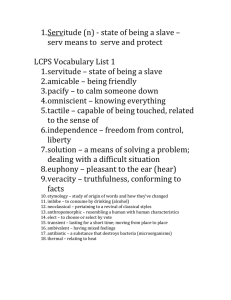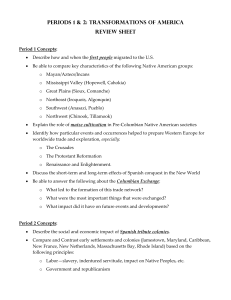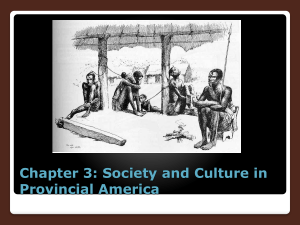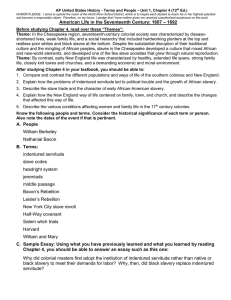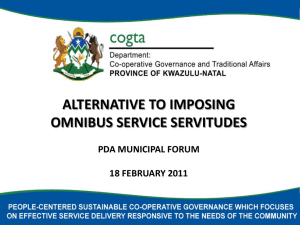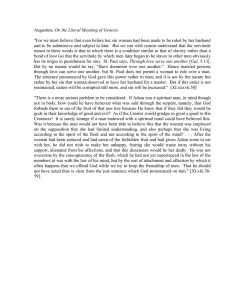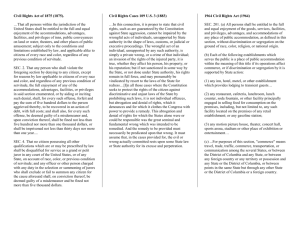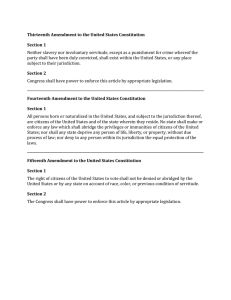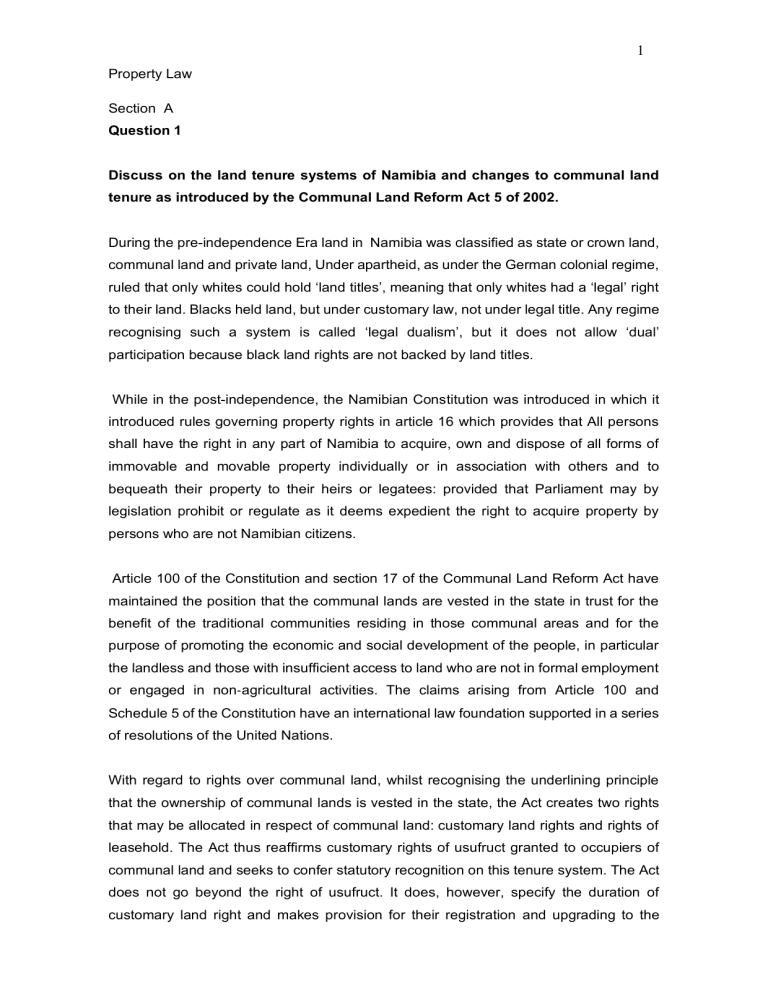
1 Property Law Section A Question 1 Discuss on the land tenure systems of Namibia and changes to communal land tenure as introduced by the Communal Land Reform Act 5 of 2002. During the pre-independence Era land in Namibia was classified as state or crown land, communal land and private land, Under apartheid, as under the German colonial regime, ruled that only whites could hold ‘land titles’, meaning that only whites had a ‘legal’ right to their land. Blacks held land, but under customary law, not under legal title. Any regime recognising such a system is called ‘legal dualism’, but it does not allow ‘dual’ participation because black land rights are not backed by land titles. While in the post-independence, the Namibian Constitution was introduced in which it introduced rules governing property rights in article 16 which provides that All persons shall have the right in any part of Namibia to acquire, own and dispose of all forms of immovable and movable property individually or in association with others and to bequeath their property to their heirs or legatees: provided that Parliament may by legislation prohibit or regulate as it deems expedient the right to acquire property by persons who are not Namibian citizens. Article 100 of the Constitution and section 17 of the Communal Land Reform Act have maintained the position that the communal lands are vested in the state in trust for the benefit of the traditional communities residing in those communal areas and for the purpose of promoting the economic and social development of the people, in particular the landless and those with insufficient access to land who are not in formal employment or engaged in non‐agricultural activities. The claims arising from Article 100 and Schedule 5 of the Constitution have an international law foundation supported in a series of resolutions of the United Nations. With regard to rights over communal land, whilst recognising the underlining principle that the ownership of communal lands is vested in the state, the Act creates two rights that may be allocated in respect of communal land: customary land rights and rights of leasehold. The Act thus reaffirms customary rights of usufruct granted to occupiers of communal land and seeks to confer statutory recognition on this tenure system. The Act does not go beyond the right of usufruct. It does, however, specify the duration of customary land right and makes provision for their registration and upgrading to the 2 status of leaseholds in order to encourage and promote the development of the communal lands. Registration only constitutes publicity or proof of title. It does not confer on the holder any additional power for example, the power to use the title as collateral. The other right created by the Act is the right of leasehold, or statutory leasehold. This right is intended to replace the existing PTO, which is granted by the Ministry of Lands for the use of land for any specific purpose, especially for commercial undertakings. In terms of the Act, the power to grant leasehold rights is vested in the Communal Land Board, and not in the Ministry of Lands. The right is granted for a maximum statutory period of 99 years. If the right is granted for a period exceeding 10 years, it is invalid unless approved by the Minister. The Act recognises the role of traditional authorities in communal land administration by vesting in the Chiefs and the traditional authorities the power to allocate communal land, subject to supervision by the Communal Land Boards. This provision should not be interpreted as a potential threat to the rights of traditional leaders under Article 102(5) of the Constitution, which provides for the establishment of a Council of Traditional Leaders by Act of Parliament ‘to advise the President on the control and utilization of communal land’. The role of the Communal Land Boards must rather be seen as administrative and advisory. Agricultural (Commercial) Land Reform Act 6 of 1995 was promulgated, this act was meant to provide the Namibian government with the necessary legal tools to acquire commercial farms for the resettlement of displaced persons, and for the purposes of land reform. Section 20, read with section 14(1), empowers the Minister to expropriate any commercial land for purposes of land reform in case of failure to negotiate the sale of property by mutual agreement. The Flexible land tenure system Act 4 of 2012 was also propose, for the introduction and development of a flexible land tenure system for Namibia references are made to ‘formal’ and ‘informal’ areas of settlement. The former is used to denote areas that are planned and surveyed. These areas are most often serviced with water, sewage removal, roads and electricity. The latter are areas where people have not settled according to prior planning, in terms of the Local Authorities Act 23 of 1992. Act 4 of 2012, It vests ownership of the communal lands in the state and creates two rights that may be allocated in respect of communal land: customary land rights and rights of leasehold. It confers statutory recognition on this tenure system. It does not grant full rights of 3 ownership to holders of customary rights of usufruct but it does specify the duration of the customary land rights and makes provision for registration. The Act has one provision relating to the allocation of land to a surviving spouse in the event of the death of the holder of the right. Allodial title It is an absolute right and is an example of a real right. In Namibia, for example, under article 100 of the Constitution the allodial title to land is vested in the state. In England the allodial title is vested in the crown. The state or the stool may by agreement grant freehold titles or leasehold. A freehold title or interest is a title or interest which is held by the proprietor for an indefinite period of time. It is carved out of the allodial title. In reality the proprietor of freehold title and his or her successors in title hold for an indefinite period until there is a failure of succession in which case the freehold title is merged with the allodial title from which it was originally carved. The title holder has a real right to land. The customary freehold is an interest in land, which is acquired by a person in his or her capacity as a subject of a stool, or as a member of a clan or a family. Such a subject of a stool or clan has a customary right to freely use part of the stool’s or family’s land In Namibia the position is different. The ownership of the communal lands is vested in the state, and the concept of customary freehold as part of the land tenure systems of Namibia is therefore merely of academic importance. Before the enactment of the Communal Land Reform Act 5 of 2002, occupiers of communal lands had certain rights, mainly generic rights of usufruct. Such existing rights have been recognised, for example, the statutory leasehold, which gives the holder a 99 year lease. Usufruct: Usufruct is a right to use property belonging to another, a grantor, and to enjoy it while maintaining the substance of such property. The dominium of the thing does not pass to the usufructuary. The usufructuary merely exercises a right of use and enjoyment of the property. This is an example of limited real right. Lease: Lease is an interest in land, which is created to last for a fixed period. Every lease must therefore have a date on which it commences and a date on which it must expire, although it may in certain circumstances be terminated before the actual date fixed for its expiration. A lease is created between a lessor and a lessee; the lessor is the landlord and the lessee is the tenant. A special relationship of landlord and tenant exists. Under the current law in Namibia, a lease of less than ten years is not required to comply with the normal formalities. But if it is for more than ten years, the lease must be in writing. 4 Tenancy: Tenancy is a limited right or interest in land. It is a right of use. A grantor, who is the landlord, retains his or her dominium or ownership in the land but grants possessory rights and use to a tenant for a fixed period of time. The major difference between tenancy and lease is that in the case of lease its duration terminates when the fixed period of the lease expires, whereas in the case of tenancy its duration could be indefinite Servitude: A servitude is a right belonging to one person to the property of another, entitling the former to either exercise a zone right as benefit in property or to prohibit the latter from exercising one or more of the powers of ownership, for example a right of way, a right of grazing, a right of access to water, et cetera. A servitude normally creates rights and obligations inter partes but if they are registered, they bind third parties who, as a result of the registration, are deemed to have knowledge of the servitude. Real security: Real security is the security a creditor may acquire by exercising a limited real right over a thing owned by the debtor to enforce payment by the debtor. Real security is, for instance, created by mortgage over immovable property and pledge over a movable thing. Question 2 Discuss the relevance of Article 16(2) of the Namibian Constitution indicating the protection given to the individual whose property is affected by the right given to the State to expropriate private property under both international law of Namibia and compare it to Ghana and SA Expropriation may be defined as the power of the state to compulsorily but lawfully, and for reasons deemed to be in the public interest, acquire ownership or some of the powers contained in ownership in respect of property to the extent that the owner is deprived of the power to use or alienate his or her property in the manner that he or she may wish to do. Expropriation constitutes a limitation on the right of ownership. The government of Namibia has the sovereign power to expropriate private property in terms of Art 16 (2), which is consistent with the norms of international law, the Namibian Constitution provides for the justification of such expropriation on grounds of public interest and the payment of compensation. Public interest, is a legal requirement falling within the sphere of political definition. It is therefore the power of the state or of any authorised state organ/authority to determine what constitutes public utility or public interest. 5 By virtue of state sovereignty, the state is empowered to exercise the right of expropriation over private property in the public interest. The origin of expropriation can thus be traced to state sovereignty. This state sovereignty vests the control of natural resources in the state. The state’s police power and its power of eminent domain is also found in the property jurisprudence of Namibia specifically under articles 16 and 100 of the Namibian Constitution. Article 100 of the Namibian Constitution vests sovereign ownership of the natural resources of Namibia in the state. Article 16, however, acknowledges private ownership but empowers the state to compulsorily acquire private property in the public interest subject to the payment of just compensation. Article 16 further states that an Act of Parliament should be promulgated for the exercise of the power of expropriation. The article does not define “public interest”. In the premise, therefore, the determination and definition of “public interest” lie is a legal requirement falling within the sphere of political definition. The Agricultural (Commercial) Land Reform Act 6 of 1995 regulates the purchase and redistribution of privately owned farms. The relevant sections of the Act in respect of acquiring agricultural land and expropriation of such land are section 14, providing for the purchasing of agricultural land by the state on a willing buyer willing seller basis, and section 20, providing for expropriation of such land and requirements therefor. In Kessl v Ministry of Lands and Resettlement & Others dealt with the issue of the welfare and interests of farm workers on commercial agricultural farms earmarked for expropriation, in which the courts considered as one of the variables to determine what constitutes public interest. It held that the power to expropriate is a legal matter, while the decision to expropriate and determine the public interest is a political one. The Namibian government has to date expropriated about nine farms. Since expropriation involves the deprivation of the right of the individual, it is important that procedural mechanisms and requirements are put in place to prevent any potential abuse of the power to expropriate. The procedure involved in the process of expropriation therefore becomes a legal requirement in the sense that it is aimed at ensuring procedural justice, transparency, recognition of the rule of law and the protection of individual rights. Article 16(2) of the Namibian Constitution clearly stipulates that the power to expropriate can only be exercised following the promulgation of an Act of Parliament. Therefore, the power becomes statutory and discretionary in nature and must be exercised subject to the provisions of article 18 of the Namibian Constitution which enjoins administrative 6 officials to comply with the principles of natural justice in the execution of administrative and executive powers. This was confirmed in Kessl by Muller J where he held that article 16 of the Namibian Constitution does not stand alone. This means, therefore, that the requirements of article 18 are applicable to the exercise of the powers of expropriation granted to the Minster by the Agricultural (Commercial Land) Reform Act and that the conduct of the administrative official, the Minister, must be fair and reasonable, as well as legitimate. The ultimate objective is to ensure that the power to expropriate is not abused. The two requirements of article 18 are, firstly, that the principle of natural justice must be satisfied in order to ensure some involvement of the owner whose property is to be considered for expropriation and, secondly, that the said owner must be given a fair hearing. This should apply not only in the context of assessing the amount of compensation but also in the decision to expropriate the property concerned. As stated by Muller J, In the Minister of Defence v Mwandinghi, he held that before the Minister can take a decision to expropriate, he or she is duty‐bound to apply the audi alteram partem principle. It implies that he or she must afford the landowner an opportunity to be heard in order to persuade him or her that he or she should not take the decision to expropriate his or her property. Subjecting the Executive’s power of expropriation to the concept of reciprocity implies justifiability of rights and judicial review of powers of expropriation. International Law Under international law, nationalisation of private property by the state or expropriation is allowed, but subject to the condition that nationalisation or expropriation is effected in the public interest and subject to payment of compensation. The UN Resolution on Permanent Sovereignty over Natural Resources, 1962, which was adopted in the case of Texaco v Libya , provides that: Nationalisation, expropriation or requisition shall be based on grounds or reasons of public utility, security, or the national interest which are recognized as overriding purely individual or private interests, both domestic and foreign. In such cases the owner shall be paid appropriate compensation in accordance with the rules in force in the state taking such measures in the exercise of its sovereignty and in accordance with international law. In any such case where the question of compensation gives rise to a controversy, the national jurisdiction of the state taking such measures shall be exhausted. Comparison between Ghanaian, South Africa vs Namibia Ghanaian Position 7 The Ghanaian Constitution guarantees the right to property and ownership of property. Under article 18 (1) every person has the right to own property either alone or in association with others. Article 20(1) provides that no property of any description or interest in or right over any property shall be compulsorily taken possession of or acquired by the State unless the following conditions are satisfied- (a) The taking of the possession or acquisition is necessary in the interest of defence, public safety, public order public morality public health town and country planning or the development or utilization of property in such a manner as to promote the public benefit; and (b) The necessity for the acquisition is clearly stated and is such as to provide reasonable justification for causing any hardship that may result to any person who has an interest in or right over the property. The constitution under subsection 2 mandates, places an obligation on the State by prescribing that where the compulsory acquisition duly authorized by the State results in displacement of any inhabitants, the State is under obligation to provide a suitable alternative land to the affected inhabitants with due regard for their economic well-being and social and cultural values. The Constitution clearly provides that any property which is compulsorily acquired in the public interest shall be used only in the public interest for which it was acquired. Where the property is not used in the public interest, the affected individual or owner of the property immediately before the compulsory acquisition shall be given the first option for acquiring the property. Upon such re-acquisition he or she shall refund the whole or part of the compensation paid to him or her or such other amount as is commensurate with the value of the property at the time of the re-acquisition. The South African Constitution contains grounds for expropriation which are also more elaborate and specific, as compared to the Namibian provisions, and include the traditional grounds of eminent domain. Under the South African Constitution section 25 (4)(a) states that property may be expropriated for a public purpose or in the interest of the public and section 25(4)(a) explains that the public interest includes the nation’s commitment to land reform to bring about equitable access to all South AFRICA’S natural resources. The public purpose requirement can be interpreted in at least three different ways: very narrowly to restrict expropriations to actual public use; slightly wider to include almost any public benefits that exceed actual public use; or very widely to include almost any purpose that is vaguely beneficial to the public weal. 8 The public purpose requirement in section 25(2) has a double function, namely to control the justification and authority for expropriations in the way that constitutional property clauses usually do, and further to ensure that this normal function of the property clause does not impede or frustrate expropriations that form part of land and other similar reforms to which the Constitution commits itself .1 The South African constitutional provision gives the South African government the power to acquire land for land resettlement and reform. Apart from the constitutional provisions pertaining to compensation the Restriction of Land Rights Act 22 of 1994 provides for the restitution of rights to land for persons or communities dispossessed of such rights after 19 June 1913 as a result of past racially discriminatory laws or practices. For the purpose of claiming restitution this Act also established the Land Claims Court. Section B This section requires you to understand the application of Principles Question 3 In the scenario = Identification the Issues, discussion, Application of relevant law to facts, and advice Servitudes questions: the Issue is normally the binding effect of the two servitudes – can they be registered or not Definition A servitude may be defined as a limited real right to another legal subject’s movable or immovable property which grants the entitled person, that is the holder of the servitude, certain specified entitlements of use and enjoyment. In the case of Lorentz v Melle & Others, the court defined a servitude as a right belonging to one person in the property of another entitling the former either to exercise some right or benefit in the property or to prohibit the latter from exercising one or other of his normal rights of ownership. The legal effect of a servitude is to diminish the rights of the owner over property for the benefit of another. Because of this bearing, the right of servitude must be clearly established. As a general rule, a servitude is only recognised as a real right if it has been registered against the land in question, unless it was created by statute or prescription. All servitudes are limited real rights. Examples of servitudes 1 AJ van der Walt 245 Constitutional Property L aw 9 are a right to draw water from the land of someone else; a right of way over the property of someone else; and a right of grazing on the land of someone else. Principle Classification Distinction between active (positive) and passive (negative) servitudes An active servitude is one which entitles the holder of the servitude to do something with regard to the servient property which the owner of the servient property must endure, for example B’s right to draw water from A’s dam. A passive servitude entitles the holder of the servitude, to prohibit the owner of the servient property from exercising any one or more of the powers normally attached to ownership. Distinction between praedial and personal servitudes There are two basic categories of servitudes, namely praedial and personal servitudes, A distinction between the 2. A praedial servitude requires at least two pieces of land. It is constituted in favour of one piece of land, the dominant tenement, over another piece of land, the servient tenement. It therefore confers a real benefit on the dominant tenement and imposes a burden on the servient tenement. Successive owners of the land will stand to benefit from the servitude. Real rights other than ownership A personal servitude, on the other hand, is always constituted in favour of the individual in his or her personal capacity. It confers on this individual the right to use the owner’s property. A praedial servitude is inseparably bound to the land it benefits and therefore when the land is alienated the new owner becomes the holder of the praedial servitude. A personal servitude cannot be transferred by its holder. In terms of the common law principle that a servitude always runs with the land, a praedial servitude, in principle, can be granted in perpetuity or, in terms of section 75(1) of the Deeds Registries Act 47 of 1937, for a limited period only. A personal servitude, on the other hand, is extinguished when the period for which it is granted lapses, or when the holder of the personal servitude dies. Where the holder is a juristic person, the servitude lapses after 100 years. A praedial servitude is indivisible, whereas personal servitudes are divisible. This means that a personal servitude, in principle, can exist over a part of the property, while a praedial servitude, in principle, exists over the whole of the affected land. Example The distinction between praedial and personal servitudes. 10 B, the owner of Farm Chalcot, grants A, in his capacity as owner of Farm Schickoft, a right of way over Farm Chalcot. The right of way is a praedial servitude to the extent that it is granted to A in his capacity as owner of Farm Schickoft. Farm Schickoft, which is benefiting from the right of way, is referred to as the dominant tenement and Farm Chalcot which serves, or is burdened in favour of Farm Schickoft, is referred to as the servient tenement. Should A later sell Farm Schickoft to D, D would of course become the owner of that farm and would therefore be entitled to exercise the right of way over Farm Chalcot. If C, owner of Farm Kalkfeld, grants to A, in his or her personal capacity, the right to draw water from the borehole on Farm Kalkfeld, this right constitutes a personal servitude because the servitude is not granted to A in his or her capacity as owner of Farm Schickoft but in his or her personal capacity. Should A sell his property to D, D would not be entitled to exercise the servitude merely because he or she has acquired ownership of the property. His or her entitlement will be determined by an express grant by C. Praedial servitude - unregistered Requirements A praedial servitude cannot exist without these two tenements. This accords with the rule of praedial servitudes that one piece of land serves another. The owner of the dominant tenement must derive some benefit from the praedial servitude in his or her capacity as owner of the land. In Van der Vlugt v Salvation Army Property Co, it was held that a right of a municipality to lay a sewer over privately owned land was not a praedial servitude because that right was not granted in favour of an identifiable dominant tenement. The servitude must offer some advantage, either present or future, to the dominant tenement whereby its value or the enjoyment to be derived from it is increased. The dominant and servient tenements must be situated close enough to allow practical exercise of the servitude. Real rights other than ownership Nobody can constitute servitude over his or her own property Nobody can hold a servitude over his or her own property (nemini res sua servit). This means that where a person owns two properties, he or she cannot register a servitude as a burden over one property in favour of the other one, not even if the ownership is held under two separate title deeds. There is an exception with respect to co‐owners because an owner can acquire a servitude over land of which he or she is only a co‐owner and conversely, co‐ owners may acquire a servitude over land that is owned solely by one of them. Example: 11 If A has granted a grazing right over his or her land to B. B cannot cede the right to C because he or she will then be creating a servitude over a servitude. A servitude must not impose active (positive) duties on owner of servient tenement. As stated earlier, a general characteristic of a servitude is that it exists over land belonging to someone else. Its existence constitutes a diminution of ownership. The holder of the servitude is entitled to some benefit from the servient tenement. However, he or she is not entitled to demand some active (positive) act on the part of the owner of the property. This means that a servitude does not oblige the servient owner to render a performance. For example, the holder of a right of way over his or her neighbour’s property cannot expect the owner of the neighbouring property to maintain the road. There are two servitudes constituting exceptions to the general rule that the holder of a servitude may not demand any positive act from the owner of the servient land. These servitudes are: (a) a servitude which imposes a duty on the owner of a servient land to keep a wall in a good state of repair; and (b) is a servitude that compels the owner of a servient property to construct a building of a certain height. Praedial servitudes are indivisible The rule is that a praedial servitude is prima facie imposed on the servient tenement as a whole to the benefit of the dominant tenement. The creation of a servitude requires the prior consent and cooperation of the joint owners of both the dominant and servient tenements. A servitude registered in favour of a dominant tenement which is subsequently subdivided, extends in favour of each and every subdivided portion of the dominant tenement. If the servient tenement is later subdivided, every portion is subject to the praedial servitude as if the servitude had been constituted at the outset against that particular tenement. Once a servitude involving two adjacent pieces of land is created, it is immaterial who the owner of either tenement is at any given time. The common expression is that ‘a servitude always runs with the land’. Therefore, neither the benefit nor the burden can be detached from the piece of land on which it is respectively conferred and imposed. Both are passed from one owner to the next when the land is transferred. The praedial servitude is granted to the owner of the dominant tenement in his or her capacity as the landowner. Unlike personal servitudes that may be constituted over either movables or immovables, praedial servitudes may only be constituted over immovables. Traditional praedial servitudes include right of way, way of necessity, water servitudes, grazing servitudes; and the power to prohibit the erection upon the servient tenement of any building (or any building higherthan a specific height). 12 (a) Right of way In terms of this servitude the holder of the servitude is entitled to walk across another person’s land or to drive cattle or vehicles across the land. When the right to drive cattle across the land is accompanied by the right to allow cattle to graze as they cross the land, the servitude concerned is called a servitude of trek path. (b) Water servitude This servitude confers on the owner of the dominant tenement the right to draw water from the servient tenement, either in furrows or pipes; to water cattle on the servient land; and to discharge water and store surplus water on the servient tenement. (c) Grazing servitude This servitude confers on the owner of the dominant tenement the right to graze a specified or unspecified number of cattle on the servient tenement. If the number of cattle is specified by the servitude, the owner of the servient tenement (servient owner) may grant others similar servitudes, provided that he or she does not prejudice the first grantee in the exercise of his or her rights. In the absence of a specific provision the owner of the dominant tenement has no exclusive right to any particular grazing area so that the servient owner may make use of his or her land, provided that he or she does not interfere with the owner of the dominant tenement’s grazing rights. Where the number of cattle is not specified, the owner of the servient tenement (servient owner) must restrict the use of his or her land to such an extent as to give the owner of the dominant tenement a reasonable opportunity to exercise his or her right; while the dominant owner cannot exclude the owner of the servient tenement (servient owner) from grazing at least a certain number of cattle which he or she requires for his or her farming operations. (d) Encroachment on servient property This refers to the right to build or otherwise encroach upon the servient property, for example, by having a verandah encroaching upon it or a balcony protruding into its airspace or rain water discharging onto it. (e) Way of necessity A way of necessity (via necessitatis) is a peculiar servitude with special requirements. It can take any of the forms of a right of way. However, there is one major difference between the conventional right of way and a way of necessity. A way of necessity does not arise from agreement but it is granted by court in order to afford a right of way in respect of land‐locked property.It does not require the consent of the servient owner. 13 Personal servitudes Creation A personal servitude is established in favour of a particular person over a thing and may confer a variety of benefits to the holder.53 It can be created for a fixed period of time or be granted until the occurrence of a future event or until the death of the beneficiary but never beyond that. Personal servitudes are normally created by agreement between the relevant parties followed by registration. Registration takes place either by means of a reservation in a deed of transfer, in the circumstances envisaged in section 67 of the Deeds Registries Act, or by the registration of a notarial deed accompanied by an appropriate endorsement against the title deed of the servient tenement. Unregistered servitudes A servitude, like any other real right, may be acquired by agreement. Such an agreement however, though binding on the contracting parties, does not by itself vest the legal title to the servitude in the beneficiary, any more than a contract of sale of land passes the dominium to the buyer.61 An agreement to establish a servitude will only create the real right concerned on registration62 and upon registration the real right comes into force and becomes binding on the parties as well as third parties. Where there is a change of ownership certain questions and principles relating to the binding effect of an unregistered servitude arise. The principles are that, firstly, prior to registration a third party, in particular the purchaser of the servient property, who has no knowledge of the servitude, is not bound to recognise it. However, as regards the relation between the parties to the agreement, the agreement would be binding although not registered. Secondly, an unregistered servitude will bind a third party who has actual or constructive knowledge of the servitude. Understand this only In the Ex parte Geldenhuys, the court held that the intention of the parties is an important clue which might help the court in deciding whether the obligation was supposed to be real or it is impossible to create a real right if the right in question clearly places the obligation upon the debtor in his or her personal capacity. The court held that one looks not at the right but the correlative obligations. In other words, the owner of the burdended property is unable to excersies the full complement of entitlements becuase of the excistance of the servitude. If the benefit favours the land, then, regardless of the identity of the owner at any given point, successive owners will benefit from the interest in the servirent land. If the benefit favours a particuler person, then, at best, the benefit exsits for the lifetime of that person. All servitudes are real rights because they burden ownership, and therefor they are registrable. 14 The Ex parte Geldenhuys case formulated the subtraction from the dominium test was formulated in in the process of this formulation, the court had to consider the following issues: (1) the effect a condition that creates a servitude has on the right of dominium; (2) whether the obligation to pay money to someone constitutes a real right or a personal right; and (3) whether the mere intention to create a real right satisfies the criterion necessary to create such a right. In arriving at this conclusion, the court had to consider the nature of a usufruct to determine its registrability and noted that a usufruct is a personal servitude, but it is also a burden upon the land and it ‘may be enforced against any and every possessor of land’. Generally speaking, therefore, any validly constituted usufruct could be registered against the land, just as any other real right in land may be so registered. Servitudes which are said to be constituting personal rights may not be registered, because the rights are merely binding on the present owner of the land and do not bind the land itself, a nd do not bind the successors in title of the present owner. Memorize this The requirements developed by the courts to determine the capability of a right to be registered was laid down in the following cases Ex Parte Geldenhuis: Facts: husband and wife left their land to their children in a will. The land would go to them as co-owners when the eldest child reached majority. The land would then be divided into portions by drawing lots. The child who got the land with the house on had to pay the others compensation. 2 conditions: 1. The time and manner of sub-division and usually co-owners are free to decide when to sub-divide – if the obligation is on the land = subtraction from dominium and it can be registered. Therefore subsequent owners are also bound. 2. The child with the house has to compensate the others – if the burden is on a specific person in his personal capacity = creditors right and it 15 can’t be registered – subsequent owners wont be bound. The 1st obligation diminishes a co-owners rights of sub-division and was intended to do so = it therefore affects all subsequent owners and is a burden on the land = REAL RIGHT AND MUST BE REGISTERED The 2nd obligation places a burden on one child only – it was intended to restore the balance – it’s a burden on a specific person in his personal capacity and doesn’t subtract from ownership = CREDITORS RIGHT AND THEREFORE CANT BE REGISTERED. In this case the court decided to register them together for convenience. In the Lorenz case: the court said that limited real rights could only be created when the result in the subtraction amounted to a subtraction of the owner’s physical use of the property. In Pearly Beach case: court reverted back to the normal subtraction test as established in Geldenhuis. 16 Cape Explosive Works v Denel: FACTS: if certain conditions registered in the title deed or omitted from the title deed are binding on owners of the property CEW sold 2 properties for development and manufacture, they inserted clauses, which gave them the right to repurchase the property, and an obligation on the transferee to notify them when the property was no longer required. The 2nd clause was not registered in the title deed. The clauses restricted the use of the land ISSUE: the main issue is whether the conditions registered in the title deed and erroneously omitted from subsequent title deeds are binding on the present owner of the property = are they real or personal rights (doctrine of knowledge) In terms of the Deeds Registry Act all real rights in respect of immovable property must be registered: in order to determine if a right was a real right the court looked at: 1. The intention of the person who creates the right to bind all successors in title and 2. The nature of the condition must be such that the registration result in a subtraction of the owners dominium Denel argued that the clause was a personal right to purchase, which could not be changed into a real right by registering it, and the 2nd condition, which was not registered, didn’t amount to a real right. Q: whether the conditions in casu gave rise to personal or real rights = if they amounted to real rights the omission from the title deed would not have extinguished them The court stated that the 2 conditions were not independent from one another and therefore couldn’t be separated – they were binding on both the transferee and successors in title and amounted to a burden on the land and thus was a subtraction from dominium. As such they were real rights and registered. 17 Question 4 - Memorize Nuisances In the Gien v Gien case, ownership was defined as follows: Ownership is the most complete real right a person can have with regard to a thing. However, the absolute entitlements of an owner exist within the boundaries of the law. The restrictions can emerge from either objective law or from restrictions placed upon it by the rights of others. Nuisance is defined in a wider sense as: ‘consisting in the infringement of the neighbours exercise of entitlements in general, or actions by the neighbouring owner or occupier that cause damage’. They maintain that: ‘in such circumstances compensation can be paid or the infringement can be prohibited by means of an interdict’. The primary requirement to establish nuisance in the sense of annoyance, nuisance in the narrow sense, is the standard of the reasonable user. In applying this standard the question to be answered is whether a reasonable man finding himself in the position of the complainant would have tolerated the nuisance. Reasonableness is therefore a variable criterion but from the authorities, one can deduce some established requirements to determine what amounts to reasonableness and what interference would be regarded as nuisance. The first criterion relates to the continuing nature of the nuisance. Nuisance in the sense of an annoyance denotes a continuing wrong so that an isolated infringement would, as a general rule, not found a cause of action unless there is a reasonable suspicion that it will be repeated.89 The second requirement relates to the acceptable degree of tolerance as laid down in the case of Prinsloo v Shaw. In this case the plaintiff brought an action for an order restraining or indicting Prinsloo (the respondent) from causing or committing a nuisance on his property or from allowing or permitting other persons to cause or commit a nuisance on the property by conducting or holding religious or other services or exercises accompanied by very loud and strident singing and yelling, singing in a monotonous whine and chant, frenzied praying, stamping of feet, clapping of hands and groaning, all in such a manner that the applicant and his family were seriously incommoded, disturbed, disquieted and interfered with, their comfort seriously diminished and the value of applicant’s property diminished. 17 18 In the supporting petition the applicant applied in the alternative for a temporary interdict pending action. The court set out the law as follows: A resident in a town and more particularly a resident in the neighbourhood, is entitled to the ordinary comfort and convenience of his home, and, if owing to the actions of his neighbour he is subjected to annoyance or inconvenience greater than that to which a normal person must be expected to submit in contact with his fellow‐men, then he has a legal remedy. The standard taken must be the standard not of the perverse or finicky or over scrupulous person, but that of a normal man of sound and liberal taste and habits. While in Pappalardo v Hau: - The resident of a township in Gauteng was ordered by the High court to allow his neighbour to insert a drainage port in the wall, which was on the common boundary between them. He appealed the courts decision. The purpose of the drainage ports was to allow rainwater, which had gathered on the neighbour’s side to flow down the natural slope of the 2 properties onto the appellants land. The High Court held: that the appellant as the owner of the lower lying property was obliged to accept the water flowing from the higher lying neighbour based on the natural flow of the water. On appeal the SCA: the applicant’s obligation in this situation is limited to the NATURAL FLOW of water between the 2 neighbouring properties. Since there was no proof of a natural flow, the right to drain the water through the drainage ports should NOT be allowed. The appeal was successful In the case of Regal v African Superslate dealt with nuisance in the broad sense, namely damage to property. It has been held by the court that the current owner of the farm cannot be held responsible for the damage caused by the use of the property by a previous owner. The court further held that neighbour law is based on the principle of reasonableness. If it was reasonably possible for the current owner to prevent the damage from happening again in future, the failure to do so would amount to an unlawful act. In the case of such an unlawful act the neighbour would be entitled to one or both of the following remedies against the current owner: (i) an interdict and/or (ii) a delictual claim for damages. The court held that the current owner had acted reasonably and the application for an interdict did not succeed. 18 19 Application of finding on relevant facts X and Y cannot hold Q and R liable for damage caused by Z's use of the property. If it was reasonably possible for Q and R to prevent the damage from happening again in future, the failure to do so would amount to an unlawful act. This would then entitle X and Y to an interdict and/or a delictual claim for damages against Q and R. In Regal v African Superslate (question based on the facts in this judgment) the court held that the current owner, in our question Q and R, had acted reasonably. Question 5 Derivative Acquisition of property A derivative acquisition of ownership occurs as a result of a bilateral transaction involving the cooperation of a predecessor in title. Property is acquired from a person who has possession and presumably ownership. This method of acquisition of ownership or transfer involves the cooperation of a predecessor in title and almost invariably there must be some juridical act to transfer ownership and in most cases this would be a contract of sale or a donation. A donation can be inter vivos or by testamentary disposition. One basic characteristic of this method of acquisition is the juridical act of transfer. There are two ways of transfer of ownership, delivery in case of movable property and registration in the case of immovables. There are legal requirements that are needed for a transfer of title. The first requirement is derived from the principle that no one is capable of transferring more rights than he or she has. There is also the element of legal capacity of the transferor and transferee to transfer and accept ownership respectively. Under the abstract and causal systems 3.1.2 Obligation creating agreements versus real agreements 19 20 A contract of sale (or a contract of transfer of ownership) involves two agreements, namely the underlying agreement (the obligation creating agreement or the causa) and the ownership transferring agreement (the so called real agreement). An ordinary contract of sale creates an obligation between two parties, the seller and the buyer. The mutual intentions to sell and purchase the thing constitute the causa or the underlying agreement. If payment is made, the seller is bound by law to make delivery and transfer ownership. This is known as the ownership transferring agreement (the real agreement). If the seller therefore receives the purchase price but does not deliver, the buyer has the right to claim delivery from the seller. The buyer’s right to demand delivery is a personal right against the seller. The obligation creating agreement thus relates to something that must be done in the future. If delivery is executed, in other words, if the real agreement is executed, a property relationship is created between the buyer and the thing. Hence, the buyer has a real right over the property. The ownership transferring agreement therefore creates a relationship directly to the thing, a property relationship. This simple illustration is meant to provide the basis for the two systems of transfer; the abstract and causa systems. The abstract and causa principles An abstract approach to the transfer of dominium is concerned with the parties’ intentions to pass and receive ownership, in the abstract, regardless of whether this is supported by an underlying causa or basis. On the other hand, the causal approach requires a linking causa or basis, typically an underlying contract – which can be seen as the delivery. The causal system prefers the interests of the owner, and ownership will pass only if there is an agreed and legal basis for this. The abstract system, on the other hand, takes more account of the interests of the transferee and third parties; ownership passes if the parties so intended, regardless of whether there is any agreed legal basis. A third party acquiring transfer from the transferee under the abstract system is more likely to get title than under a causal system. Namibian property law is based on the abstract system of property law. In the Namibian case of Oshakati Tower (Pty) Ltd v Executive Properties CC & 3 Others, referring to the application of the abstract system in Namibia and stated as follows: It is common cause 20 21 between the parties that the land registration system, in Namibia is an abstract system, which is the same in South Africa. In this system two separate agreements are recognised, namely the underlying agreement and the real agreement. A defect in the first agreement does not prevent valid transfer. In respect of the real agreement it is a requirement it should not only be voidable, but it should be void ab initio because of a mistake or fraudulent misrepresentation. A forgery would certainly also render the agreement void. For transfer, the owner must have the intention to pass ownership. If there was no such clear intention to transfer ownership, ownership does not pass. The authorities further make it clear that non‐compliance with a statutory requirement may render contracts unenforceable, depending on the intention of the legislature. In this regard non‐compliance with a statutory requirement, as set out in section 228 of the Companies Act, may render the real agreement unenforceable and void. The learned Judge further stated that under an abstract system of passing of ownership the mere intention of the parties to pass ownership is sufficient without reference to the underlying causa for the transfer. This principle originated in Roman law and was developed further by natural law jurists of the seventeenth century, and accepted in modern law. The abstract principle guarantees certainty in that it disallows the invalidity of an underlying causa to affect the existence or validity of a transfer. The real agreement to pass ownership is treated in abstracto, that is, totally independently from the contractual agreement which provides the causa for the transfer. Although the abstract system simplifies matters for the transferee it does not leave the transferor, who has transferred an object by virtue of an invalid causa, without a remedy. Since ownership passes to the transferee, the transferor is deprived of his rei vindicatio. However, he or she may still claim by way of condictio on the ground of unjust enrichment. The abstract principle is by no means absolute and several exceptions exist. Firstly, certain forms of invalidity of the contractual agreement are considered so material that they affect the real agreement and also, for example, where recognition of the validity of the transfer will conflict with an absolute statutory prohibition. Secondly, it seems possible for parties to the contractual agreement to provide that the transfer of ownership will only be valid if the causa for the transfer is valid. Such a term can also be implied from the circumstances of the case. 21 22 Van der Merwe, discusses the effect of the abstract system on land registration and what the requirements are, He makes it clear that the owner of the property must have the intention to transfer ownership at the moment when ownership passes. He deals with the difference between the underlying agreement and the real agreement and states the following: In terms of an abstract system of the transfer, the passing of ownership is wholly abstracted from the agreement giving rise to the transfer and is not made dependent on such an agreement. It is immaterial whether such an agreement is void, voidable, putative or fictional. The juristically‐ minded do not even talk in terms of a causa giving rise to the obligation to transfer but only require a serious intention on the part of the parties to transfer ownership. In terms of the abstract system a clear distinction is thus drawn between the agreement given rise to the transfer and the real agreement in which the parties agree to pass ownership. Emphasis is placed on the real agreement which exists independently of the agreement giving rise to the transfer. The invalidity of the latter agreement has no influence on the validity of the real agreement. If there is a serious intention to transfer ownership, ownership passes to the transferee, who can in turn validly pass transfer to a third party. The original owner in such a case loses ownership of his thing and he has in appropriate circumstances only a personal action, namely the condictio based on unjust enrichment on the ground of the loss suffered by him. The real agreement is described as follows by Van der Merwe: Under the abstract system a real agreement, namely an agreement to transfer and accept ownership, is required for transfer of ownership. In every instance it must consequently be determined factually whether a real agreement had indeed been reached. If the real agreement is merely voidable, for example as a result of undue influence, ownership will pass if the agreement had not been vitiated before transfer. If, however, the real agreement is void, having been induced by the fraudulent misrepresentations or by mistake ownership will not pass. He continues: Certain contracts are unenforceable because they do not comply with certain statutory requirements: thus writing, official approval or a certain manner of achieving an object may be prescribed. Whether a real agreement or performance in terms of such an enforceable contract is vitiated by the defect in the preceding contract depends on the intention of the legislature in rendering such a contract void on the ground of non‐compliance with a certain 22 23 requirement. The courts have to ascertain the intention of the legislature from the statutes itself and in certain instances it may well be that the legislature intended to render not only the preceding contract but also the real agreement unenforceable. In this case, the court granted the order for the de‐registration of the rights. This case inter alia illustrates the principle that the application of the abstract principle is by no means absolute and that the courts have the discretion in appropriate cases to annul the registration of the transfer of property. Transfer by registration Transfer of real rights in immovable property is effected by means of registration. Section 16 of the Deeds Registry Act 47 of 1937 provides that: Save as otherwise provided in this Act or in any other law the ownership of land may be conveyed from one person to another only be means of a deed of transfer executed or attested by the registrar, and other real rights in land may be conveyed from one person to another only be means of a deed of cession attested by a notary public and registered by the registrar. 23
